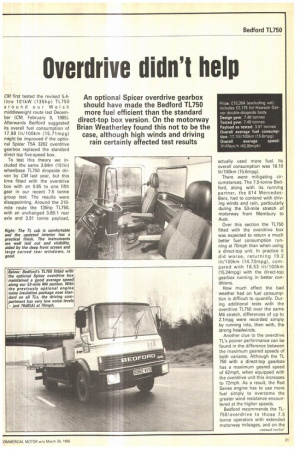Overdrive didn't help
Page 25

Page 26

If you've noticed an error in this article please click here to report it so we can fix it.
CM first tested the revised 5.4litre 101kW (135hp) TL750 around our Welsh middleweight route last December (CM, February 9, 1985). Afterwards Bedford suggested its overall fuel consumption of 17.98 lit/100km (15.71mpg) might be improved if the optional Spicer T5A 3262 overdrive gearbox replaced the standard direct top five-speed box.
To test this theory we included the same 3.84m (1511n) wheelbase TL750 dropside driven by CM last year, but this time fitted with the overdrive box with an 0.85 to one fifth gear in our recent 7.5 tonne group test. The results were disappointing. Around the 210mile route the 135hp TL750, with an unchanged 3.89:1 rear axle and 3.91 tonne payload,
actually used more fuel. Its overall consumption was 18.10 lit/100km (15.6mpg).
There were mitigating circumstances. The 7.5-tonne Bedford, along with its running partner, the 814 MercedesBenz, had to contend with driving winds and rain, particularly during the 53-mile stretch of motorway from Membury to Aust.
Over this section the TL750 fitted with the overdrive box was expected to return a much better fuel consumption running at 70mph than when using a direct-top unit. In practice it did worse, returning 19.2 lit/100km (14.73mpg), compared with 18.53 lit/100km (15.24mpg) with the direct-top gearbox running in better conditions.
How much effect the bad weather had on fuel consumption is difficult to quantify. During additional tests with the overdrive TL750 over the same M4 stretch, differences of up to 2.1mpg were recorded simply by running into, then with, the strong hedwinds.
Another clue to the overdrive TL's poorer performance can be found in the difference between the maximum geared speeds of both variants. Although the TL 750 with a direct-top gearbox has a maximum geared speed of 62mph, when equipped with the overdrive unit this increases to 72mph. As a result, the Red Series engine has to use more fuel simply to overcome the greater wind resistance encountered at the higher speeds.
Bedford recommends the TL750/overdrive to those 7.5 tonne operators with extended motorway mileages, and on the M4 it certainly proved to be a fast mover. Between Membury and Aust, it maintained 70mph effortlessly, covering the 53 miles at a higher than average speed of 106km/h (65.7mph).
At these speeds, however, the 5.4-litre engine, even revving at a lower 2,500rpm, clearly loses out on fuel economy. There is a strong argument for a speed limiter set between 60-65mph to be fitted, if only to allow the overdrive fifth gear to save fuel.
And save fuel it can, for running at lower speeds around the remaining 158 miles of mixed A-roads, the TL750/overdrive combination returned a better 17.75 lit/100km (15.91mph) compared with 17.80 lit/100km (15.81 mpg) given by the 1L750 with the direct-top box.
Bedford's own computer predictions on the overdrive box seem to reinforce the speed limiter argument. At a steady 62mph it calculates a consumption of 15.97 mpg for a TL750 with a direct-top box. At this speed, however, an overdrive TL750 would be expected to return 17.15mpg.
Driving over the nonmotorway sections, however, it soon became apparent how much the Bedford TL's hill performance was affected by the overdrive option. Climbing the long A40 bank outside Monmouth, the TL750/overdrive took 16 seconds longer than its direct-top alter ego.
One way to overcome this drawback is to change down a lot sooner, at around 2,000rpm, thus keeping up momentum, rather than let the Red Series engine lug down to 1,200rpm, marked at the end of the green economy sector on the rev counter, as can be done with the direct-top TL.
For those operating in hilly country who may be thinking of specifying the TL750 with an overdrive box, this negative effect should seriously be considered, as should reverting back to the standard 4.38:1 rear axle.
The new Spicer five-speed box fitted to our vehicle was, understandably, stiff, and highlighted the rather awkward change from first to second ratios. After more use it would no doubt become easier to use. Like the direct-top gearbox, there is a noticeable gap between second and third ratios. The 3.26:1 second gear ratio on the overdrive box is also a little too deep to be used when pulling away from rest fully laden.
The controls are easy to use, although the park brake is tucked away down the righthand side of the driver's seat next to the door. The standard Cam Gears steering is particularly good — light and precise — with just the right amount of feedback.
Front taper leaf and rear multi-leaf springs give the TL750 a good ride, although slightly softer than the 79.10 Iveco.
The TL750, equipped with the 5.4-litre turbocharged 135hp engine and Spicer overdrive gearbox, is certainly capable of good journey times, particularly on long motorway runs. At top speeds, however, the TL750 driver must resist the temptation to run at 70 mph if fuel consumption is to be acceptable.
The revised TL cab provides one of the best working environments of any 7.5 tonne truck currently sold, although the 135hp engined chassis price of E12,520 clearly reflects the TL's above average specification.
























































































































































